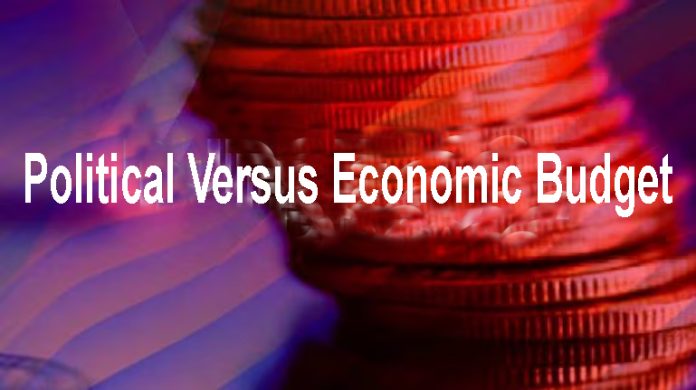By K Raveendran
Finance Minister Nirmala Sitharaman stepped up to her budget rostrum in the Lok Sabha with a resolute demeanour, a symbolic gesture marking the unveiling of what many had anticipated as a transformative federal budget for the fiscal year 2024-25. Yet, what unfolded before the nation on July 23 was not a conventional economic blueprint but rather a delicate coalition budget, meticulously crafted to appease disparate political alliances. In a strategic manoeuvre reflecting the exigencies of governing with a precarious mandate, Sitharaman presented what could be characterised as a political budget, a document attuned more to the exigencies of coalition politics than the traditional imperatives of economic stewardship.
And the most miserable part is that she was not even feeling embarrassed that her gamesmanship would be seen as blatant aberration to the otherwise solemn act of budget making.
Against the backdrop of a minority BJP government shored up by the regional powers of Bihar and Andhra Pradesh, the budget’s contours bore the indelible fingerprints of compromise and accommodation, where numbers often dictate policy more than principles or prudence. The omission of expected measures to curb inflation underscored the delicate balance required to satisfy regional allies without jeopardizing broader economic stability—a deft tightrope walk that reflected the intricacies of coalition governance in contemporary India.
Central to Sitharaman’s address was a purported emphasis on employment generation—a perennial concern exacerbated by the economic aftershocks that BJP’s electoral setbacks brought to the fore in the party’s post-poll deliberations. Yet, conspicuous by their absence were concrete, target-specific proposals to substantiate this overarching commitment. The absence of a robust roadmap for job creation and a dearth of substantive measures capable of translating lofty rhetoric into tangible outcomes for the millions grappling with underemployment and joblessness were too obvious to be missed.
The budget’s pivot towards a political calculus over a purely economic one was underscored by the interplay of fiscal priorities tailored to assuage the exigencies of the regional partners. Nitish Kumar and Chandrababu Naidu, pivotal to the BJP’s tenuous grip on power, loomed large in the budgetary deliberations, their strategic imperatives often trumping the universal demands of economic prudence. The contours of resource allocation bore the imprimatur of these regional satraps, foregrounding the pragmatic exigencies of coalition governance over the idealism of unfettered economic stewardship.
Sitharaman’s overtures towards inclusive growth resonated with the imperatives of political expediency, yet brought out the inherent contradictions that bedeviled this purported commitment. The absence of tangible measures to curb inflation—a central bugbear for the common man grappling with escalating costs of essentials—underscored the discordant notes between politics and economics. It laid bare the tension between short-term political imperatives and the demands of sustainable economic stewardship—a dissonance that threatened to undermine the government’s broader credibility on matters of fiscal prudence as well as the dictates of constitutional propriety in the formulation of Union budgets.
Nirmala Sitharaman’s 2024-25 budget is bound to stir a storm of criticism and disappointment, particularly from states traditionally at odds with the ruling BJP-led coalition. In a departure from the federalist ethos that typically underpins India’s budgetary allocations, her fiscal blueprint appeared to diss equitable distribution of resources, leaving opposition-ruled states like Kerala, Tamil Nadu and Karnataka conspicuously absent from significant mentions or substantive allocations.
The absence of any meaningful acknowledgment or allocation for states governed by opposition parties underscored a glaring departure from the federalist principles enshrined in India’s constitutional framework. Historically, India’s budgetary process has sought to balance the fiscal needs and priorities of diverse states, irrespective of political affiliations, in adherence to the principle of cooperative federalism. However, Sitharaman’s budgetary strategy appeared to tilt decisively towards placating coalition partners.
For opposition-ruled states, the budget’s marginalization translated into more than just fiscal neglect; it symbolized a systemic disenfranchisement and a disregard for the diverse economic imperatives that characterize the federal structure. States like Kerala and Tamil Nadu, known for their robust economic contributions and distinctive developmental challenges, found themselves relegated to the periphery of fiscal discourse, their pressing needs overshadowed by the imperatives of coalition politics.
In Kerala, known for its emphasis on social welfare and human development indices, the budget’s neglect resonated deeply. The absence of targeted allocations for critical sectors like healthcare, education, and infrastructure underscored a disconnect between the Centre’s fiscal priorities and the pressing realities on the ground. With an economy heavily reliant on sectors like tourism and remittances, Kerala’s exclusion from substantive budgetary provisions represented a missed opportunity to bolster resilience and foster sustainable growth in the face of evolving global challenges.
Similarly, Tamil Nadu—with its formidable industrial base and significant contributions to India’s GDP—found itself sidelined. The state’s developmental aspirations, particularly in sectors like manufacturing, agriculture, and urban infrastructure, were relegated to the margins, overshadowed by the exigencies of political accommodation elsewhere. The lack of targetted investments to catalyse job creation, enhance industrial competitiveness, and bolster agricultural resilience underscored a myopic fiscal approach that prioritized short-term political gains over long-term economic sustainability.
In Karnataka, another state governed by an opposition party, the echoes of discontent were palpable. Despite its status as a key economic hub and technological powerhouse, Karnataka’s aspirations for infrastructure development, digital innovation, and sustainable urbanization did not find place in the budgetary discourse.
The repercussions of Sitharaman’s budgetary strategy extends beyond mere fiscal allocations; they will reverberate through the corridors of state governance, sparking outcry and apprehension among opposition leaders and policymakers. The perceived neglect of opposition-ruled states threatens to deepen existing fault lines and amplify regional grievances, potentially undermining the collaborative spirit essential for India’s developmental trajectory. (IPA )


